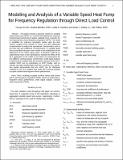Modeling and Analysis of a Variable Speed Heat Pump for Frequency Regulation Through Direct Load Control
Author(s)
Kim, Young-Jin; Kirtley, James L.; Norford, Leslie Keith; Kirtley, James L., Jr.
DownloadModeling and Analysis of a Variable.pdf (1.882Mb)
OPEN_ACCESS_POLICY
Open Access Policy
Creative Commons Attribution-Noncommercial-Share Alike
Terms of use
Metadata
Show full item recordAbstract
This paper presents a dynamic model of a variable speed heat pump (VSHP) in a commercial building that responds to direct load control (DLC) signals, updated every 4 s, for the improvement of grid frequency regulation (GFR). The model is simplified for real-time simulation studies with the time horizon ranging from seconds to hours, but still sufficiently comprehensive to analyze the operational characteristics such as the heat rate and coefficient of performance. A variable speed drive-controlled induction motor model is also established for the adjustment of the VSHP input power. A dynamic model of an experimental room is then developed to estimate the effect of the DLC application to the VSHP on its indoor air temperature for two different cooling systems. Furthermore, small signal analysis is performed to evaluate both the transient response of the DLC-enabled VSHP and its contribution to GFR. Finally, with an isolated microgrid implemented with Matlab/Simulink, simulation studies demonstrate that the VSHP can be effectively exploited as the DLC-enabled load while still ensuring building occupant comfort and long-term device performance.
Date issued
2014-05Department
Massachusetts Institute of Technology. Department of Architecture; Massachusetts Institute of Technology. Department of Electrical Engineering and Computer ScienceJournal
IEEE Transactions on Power Systems
Publisher
Institute of Electrical and Electronics Engineers (IEEE)
Citation
Kim, Young-Jin, Leslie K. Norford, and James L. Kirtley. “Modeling and Analysis of a Variable Speed Heat Pump for Frequency Regulation Through Direct Load Control.” IEEE Transactions on Power Systems 30, no. 1 (January 2015): 397–408.
Version: Author's final manuscript
ISSN
0885-8950
1558-0679